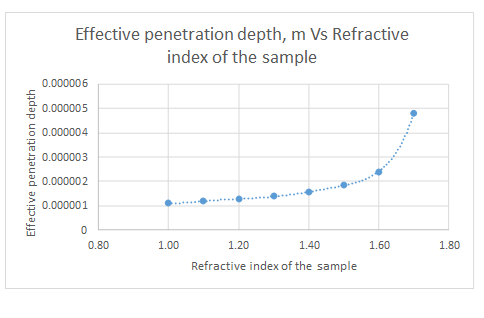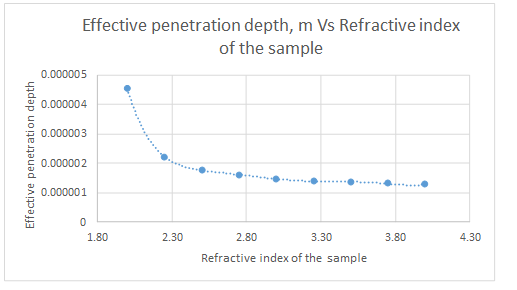
Concept explainers
(a)
Interpretation:
For an angle of incidence of 450, the effective penetration depth of the evanescent wave should be determined. Penetration depth if the angle changed to 600 should be determined.
Concept introduction:
The effective penetration depth can be calculated as follows:
Here,
Answer to Problem 17.13QAP
When the angle of incidence = 450
When the angle of incidence = 600
Explanation of Solution
When the angle of incidence = 450
When the angle of incidence = 600
(b)
Interpretation:
The penetration depths for sample refractive indexes varying from 1.00 to 1.70 in steps of 0.10 should be determined. Penetration depth should be plotted as a function of refractive index. The refractive index for which the penetration depth becomes zero should be determined.
Concept introduction:
Answer to Problem 17.13QAP
The plot is represented as follows:

Explanation of Solution
The data given is as follows:
| Refractive index of sample | dp, m |
| 1.00 | 1.12597E-06 |
| 1.10 | 1.19018E-06 |
| 1.20 | 1.27491E-06 |
| 1.30 | 1.39125E-06 |
| 1.40 | 1.56143E-06 |
| 1.50 | 1.8387E-06 |
| 1.60 | 2.40057E-06 |
| 1.70 | 4.80114E-06 |
The plot for the data is represented as follows:

From the graph, it can be seen that the refractive index never approaches zero.
(c)
Interpretation:
For a sample with a refractive index 1.37 at 2000 cm-1 and incident angle of 450, the penetration depth versus the ATR crystal refractive index should be plotted.
Concept introduction:
The effective penetration depth can be calculated as follows:
Here,
Answer to Problem 17.13QAP
Ge crystal will give smaller penetration depth as a refractive index of the crystal increases, the effective penetration depth decreases.
Explanation of Solution
The data given is as follows:
| Refractive index of Crystal | dp, m |
| 2.00 | 4.53849E-06 |
| 2.25 | 2.21456E-06 |
| 2.50 | 1.78166E-06 |
| 2.75 | 1.58661E-06 |
| 3.00 | 1.47477E-06 |
| 3.25 | 1.40242E-06 |
| 3.50 | 1.35201E-06 |
| 3.75 | 1.31509E-06 |
| 4.00 | 1.28702E-06 |
The plot is represented as follows:

Ge crystal will give smaller penetration depth as a refractive index of the crystal increases, the effective penetration depth decreases.
(d)
Interpretation:
The effective penetration depth at 3000 cm-1, 2000 cm-1 and 2000 cm-1 should be determined.
Concept introduction:
The effective penetration depth can be calculated as follows:
Here,
Answer to Problem 17.13QAP
At 3000 cm-1
At 2000 cm-1
At 1000 cm-1
Explanation of Solution
At 3000 cm-1
At 2000 cm-1
At 1000 cm-1
In case of analyzing aqueous samples, pouring shallow amount over the surface of the crystal is sufficient. Since trace amounts are used to analyze, absorption by the aqueous solvent is not a problem.
(e)
Interpretation:
The principles of the new method to obtain a depth profile of a sample surface using ATR spectroscopy should be described.
Concept introduction:
In ATR spectroscopy through the ATR crystal, an infrared beam is passed such that it reflects off the internal surface at least once when in contact with the sample. This reflection results in an evanescent wave which goes into the sample. The penetration depth is determined by the wavelength of IR beam, angle of incidence, refractive indexes of sample and the crystal.
Explanation of Solution
A new depth profiling method using multiple-angle ATR/FT-IR spectroscopy has been developed.
First, a profile frequency is defined then the stratified medium is defined. Matrix A is generated from interpolated absorptances and matrix E is generated from estimated mean square electric fields. Linear equations of absorptance by SVD method is solved and the first estimated refractive index profile from matrix X is calculated. Nonlinear fittings of the reflectances are determined by Levenberg-Marquadt method. Finally, complex refractive index profile is obtained.
Want to see more full solutions like this?
Chapter 17 Solutions
Principles of Instrumental Analysis
- The measured absorbance of a solution held in a sample container witha path length of 3 cm is 0.96. What is the concentration of the solution if the molar absorptivity of this analyte is 139 L Mol1cm 1?arrow_forward(a) What is the main difference between a UV-Vis spectrophotometer and a spectrofluorometer? (b) What is the main advantage of using a spectrofluorometer in quantitative analysis?arrow_forwardI) Diamond crystallises in a face-centred cubic structure with a = 3.5625 Å. Calculate the d-spacing and peak position of the first allowed peak (i.e. the peak with the lowest hkl value that meets the selection rules) using a wavelength of 0.71073 Å. II) A solvothermal synthesis gave rise to a mixture of two crystalline phases: one phase consists of 50-65 μm octahedral crystallites while the other phase consists of 150-180 μm hexagonal plates. Identify a separation technique that would likely be effective in separating these materials.arrow_forward
- 2. Answer ALL parts. (a) The absorbance of compound A was measured in a 1.00 cm cuvette at 238 nm. A 3.96 x 10 M solution of compound A exhibited an absorbance of 0.624. A blank solution containing only the solvent had an absorbance of 0.029 at the same wavelength. Calculate the molar absorptivity of compoundA in m' mole". (i) The absorbance of an unknown solution of Compound A in the same solvent and cuvette was 0.375 at 238 nm. Find the concentration of A in the unknown. (iii) A concentrated solution of Compound A in the same solvent was diluted from an initial volume of 2.00ml to a final volume of 25 ml and then had an absorbance of 0.733 under the same conditions. What is the concentration of A in the concentrated solution? (iv) What type of cuvette was used in the above analysis? Justify your answer. (b) Name ONE advantage and ONE disadvantage of a linear photodiode array detector compared to a traditional photomultiplier based spectrometer. (c) Why is an FTIR spectrum digital in…arrow_forward3.) The accuracy of a spectrophotometer is evaluated by preparing a solution of 60.06 ppm K2Cr2O7 and measuring its absorbance at a wavelength of 350 nm in a cell with a pathlength of 1.00 cm. The expected absorbance is 0.640. What is the expected molar absorptivity of K2Cr2O7 at this wavelength? 4.) A solution’s transmittance is 35.0%. What is the transmittance if you dilute the solution to half of its initial concentration?arrow_forwardSolutions of fluorene (diphenylmethane) in benzene can be analyzed by making use of its absorbanceat 301 nm wavelength. If a solution of fluorene of unknown concentration in benzene exhibits anabsorbance of 0.720 in a 1.00-cm cuvette cell. What is the concentration of fluorene? (Ans. c = 6.55x10 -5 M)arrow_forward
- Atomic Spectroscopy (a) In terms of spectral shape, how are atomic spectra different from molecular spectra? What is the source of this difference? (b) Describe the decision-making process for picking a line for atomic emission analysis of a given analyte. (c) For quality assurance, spike recovery is not sufficient to establish confidence in an analytical procedure. Explain this statement. What should be done instead to demonstrate satisfactory performance of an instrumental method (including elemental analysis). (d) Find a literature example of atomic spectroscopy used for elemental analysis. State the operating conditions with sufficient detail to reproduce the analysis; Please answer very soon will give rating surely All questions complete Answer needed Please help mearrow_forwardThe absorbances of solutions containing K2CrO4 in 0.05 M KOH were measured in a 1.0-cm cell of 375 nm. The following results were obtained: Calculate the linear equation of the calibration curve.arrow_forward5. A 7.25x104 M solution of Potassium cyanide (KCN) has a transmittance of 45.2% when measured in a 2 cm cell at a wavelength of 525 nm. Calculate (a) the absorbance of this solution; (b) the molar absorptivity of KMNO4.arrow_forward
- The concentration of a glucose solution was determined via a DNS assay, and it was determined that a 150.0 mM solution would have an absorbance of 0.156. If the pathlength used was 0.95 cm, what is its molar absorptivity constant, in L cm mol 1?arrow_forward4 Determine the time in seconds required to sputter 50 nm of Si using a 10 µA/cm2 beam of 45 keV ions of (a) Ne, (b) Kr, and (c) Xe.arrow_forwardRadiation of wavelength 268 nm passed through 1.5 mm of a solution that contained benzene in a transparent solvent at a concentration of 0.080 mol dm-3 . The intensity of the radiation is reduced to 22 per cent of its initial value (so T = 0.22). (a) Calculate the absorbance and the molar absorption coefficient of the benzene. (b) What would be the transmittance through a cell of thickness 3.0 mm?arrow_forward
 Principles of Instrumental AnalysisChemistryISBN:9781305577213Author:Douglas A. Skoog, F. James Holler, Stanley R. CrouchPublisher:Cengage Learning
Principles of Instrumental AnalysisChemistryISBN:9781305577213Author:Douglas A. Skoog, F. James Holler, Stanley R. CrouchPublisher:Cengage Learning

